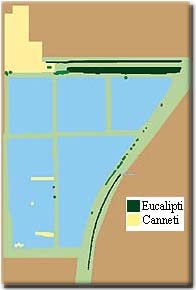| | | Roman Coastal Reserve | | | Zones | | | Maccarese Ponds | | | History... |

 |
The ponds, built in 1970 for hunting purposes, were, according to a
plan of productive reconversion of the Maccarese Estate, turned into a
complex of ponds to be used for intensive pisciculture. The project
was a failure and the ponds were subsequently abandoned: therefore allowing
for the creation of a singular biotype of damp zone with eutrophic
characteristics, shortage of oxygen in the water and consequent production
of algal biomass in a quantity great enough to bring about the growth
of complex alimentary chains and thus the presence of numerous species
of animals. Among these, numerous species of birds, both sedentary
and migratory, can be found.
At the beginning of the 'seventies, these ponds were discovered, from an ornithological viewpoint, by F. Petretti and, since then, have been an object of study and of specialistic publications. Thanks to the province, in 1979 the area and a wide surrounding zone, was precluded from hunting. This has allowed the contingent of wintering birds to increase considerably in number. |
After the failure at Maccarese and a period of confused management in 1986, several Companies were re-established, within the IRI group, and the SOGEA Company was formed. SOGEA is presently in charge of the running of the territory in which the ponds are situated.
On 13 February 1987, thanks to an initiative taken by counsellor Mastrantoni, a parliamentary bill (no. 390) was presented, proposing the institution of a Nature Reserve, but the motion did not pass due to the well-known governmental crises.
While the project to launch the Coastal Park failed to take-off, inspite of the famous "Pavan Decree", unfortunately an area near the present ponds was permanently reclaimed: an area of small marshes, reed-beds and reed thickets (proof of the existence of the old swamp area) as well as another two old ponds (about 1 km away) that are in an advanced state of decay, in that they are being progressively filled-in by the earth surrounding them.
![]() This Web Site has been realized and updated by the Lega Italiana Protezione
Uccelli
This Web Site has been realized and updated by the Lega Italiana Protezione
Uccelli
(Italian Society for the Protection of Birds)
- Roman Coastal Branch. For any information contact
us: